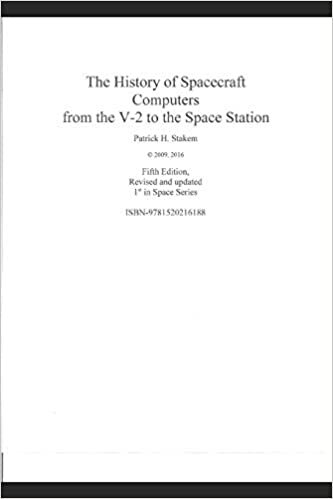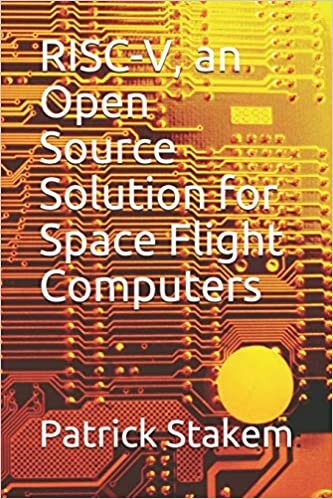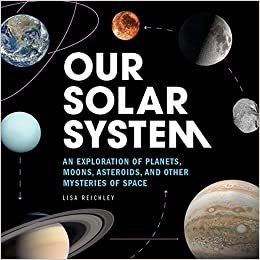The History of Spacecraft Computers from the V-2 to the Space Station
The History of Spacecraft Computers from the V-2 to the Space Station adlı kitabı telefonunuzda, bilgisayarınızda veya tabletinizde EPUB biçiminde okumak için "okuyucu" uygulamasını ücretsiz veya satın almanız gerekir - siz karar verin. İşlevsel olarak özgür "okuyucular" nadiren ücretli olanlara yol verir ve bazen onları aşar. Bazen daha yavaş çalışır veya reklam içerir. Ücretli uygulamalar daha güzel görünür, daha az yavaşlar, aynı işlevsellik ile telefonun belleğinde genellikle daha az yer kaplarlar. Veya Patrick Stakem adresinden çevrimiçi olarak The History of Spacecraft Computers from the V-2 to the Space Station kitap okumak için bir site bulabilirsiniz. EPUB, kayan bir düzene sahip bir biçimdir, yani kitabın metni, örneğin The History of Spacecraft Computers from the V-2 to the Space Station, akıllı telefonunuzun veya tabletinizin ekran boyutuna otomatik olarak ayarlanır - manuel olarak ölçeklendirmeniz gerekmez. Son aşamada, biçim bilgisayarlar, akıllı telefonlar ve tabletler tarafından desteklenen 5.2 sürümüne güncellenir. Gutenberg Serbest Kütüphanesi, 2008 yılında The History of Spacecraft Computers from the V-2 to the Space Station gibi kitapları ve diğer basılı yayınları ve kitapları dijitalleştirmek ve saklamak için bu biçimi seçti. Yavaş yavaş, 2010'a kadar, daha önce kendi LRF uzantısını (BBeB) kullanan Sony, belgeleri bu biçime dönüştürdü. E-kitapların ve "okuyucuların" artan popülaritesi ile birlikte popülerlik kazanıyor. İlk kez 1999'da ABD'de ortaya çıktı, farklı olarak adlandırıldı - Açık eKitap Yayını (OEB). Geliştirici - Uluslararası Dijital Yayıncılık Forumu, IDPF kısaltması: Uluslararası Dijital Yayıncılık Forumu. 2007 yılında, “forum”, doğrudan “Elektronik Yayıncılık” olan ve tam anlamıyla “Elektronik Yayıncılık” olarak kısaltılan geliştirmenin son versiyonunu tanıttı.
| Yazar | Patrick Stakem |
|---|
BrownTrout Publisher Independently published Collectif Almanca Flower Love Press Türkçe Fransızca Routledge Rusça HACHETTE LIVRE-BNF LAP LAMBERT Academic Publishing İtalyanca Dazzle Book Press U.S. Department of the Interior Kolektif Book on Demand Ltd. İngilizce CreateSpace Independent Publishing Platform
indir okumak internet üzerinden
| Yazar The History of Spacecraft Computers from the V-2 to the Space Station | Patrick Stakem |
|---|
This book documents the development of missile and spacecraft guidance computers from the earliest efforts to the current Space Station and satellite onboard systems. This book developed from the author's presentation at the Johns Hopkins University’s Applied Physics Laboratory in 2009 for the Workshop on Flight Software. This fourth edition updates the material to the state of the art in 2014, with discussions of the latest approaches and architectures, including Orion. More references are included, and errors were corrected. This edition has grown to be three times the size of the original. There is coverage of new missions and systems, the emerging Cubesats, SpaceX, and Orion. There is coverage of Soviet flight computers. The computing infrastructure of the International Space Station is discussed.Computers for onboard spacecraft use evolved from the computers used to guide missiles. The computers allowed for a degree of autonomy for the spacecraft, allowing operations to continue without direct ground communications.The early missile guidance computers were located in underground bunkers, and transmitted their steering commands to the missile via a radio link. The missiles of the day had no inertial guidance (and, GPS was years in the future), and went ballistic after the engine burned out, a period of just several minutes. After that, the laws of physics took over.The early manned missions such as Project Mercury, were basically a man in a can atop a ballistic missile, and did not incorporate computing power. The later Gemini and Apollo missions relied more and more on onboard compute power, while driving the state of the art.The early Earth-orbiting spacecraft did not make use of computers, but did have the capability of storing commands onboard for execution at a later time. This storage was sometimes on magnetic tape.One of the first computers onboard a spacecraft was the OBP (On-Board Processor) on the OAO-C Orbiting (Astronomical Observatory) spacecraft. Later, the Advanced Onboard Processor (AOP) was developed as a follow-on. The NASA Standard Spacecraft Computer flew on many missions. The architecture has evolved from custom-built units to radiation-hard versions of commercial microprocessors to reconfigurable FPGA-based units.A section on flight software shows the evolution of linux as a preferred onboard operating system. CoThis book discusses primarily unmanned US spacecraft, with some discussion of the Saturn and Shuttle computers. Coverage is included for the planetary missions. Information on the next generation of space computers, now in development, is included. A section on how flight computer went horribly wrong is included, along with a glossary of terms.
Son kitaplar
İlgili kitaplar
Our Solar System: An Exploration of Planets, Moons, Asteroids, and Other Mysteries of Space
indir bedava
H Journal: A Monogram H Initial Capital Letter Notebook For Writing And Notes: Great Personalized Gift For All First, Middle, Or Last Names (Rose Gold Smoke Fire Swirl Print)
indir bedava
Our Solar System: An Exploration of Planets, Moons, Asteroids, and Other Mysteries of Space
indir bedava
H Journal: A Monogram H Initial Capital Letter Notebook For Writing And Notes: Great Personalized Gift For All First, Middle, Or Last Names (Rose Gold Smoke Fire Swirl Print)
indir bedava


















